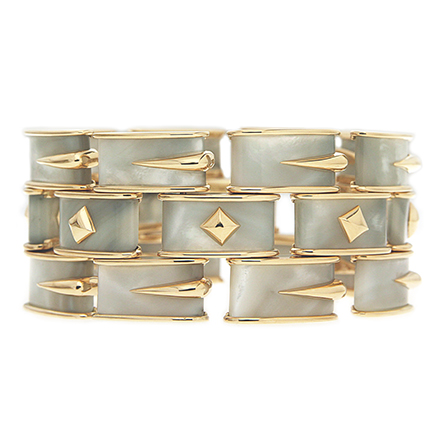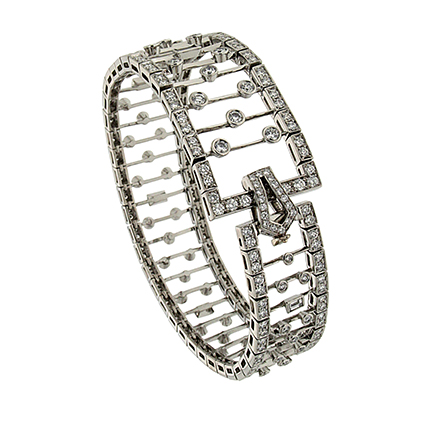Glossary of Bracelet Types
 Just as there is more than one way to decorate a bracelet, there are multiple ways to create one. Styles can be rigid or flexible, wide, slender or even jingle as the wearer moves. Many bracelet variations have their own names to distinguish them from other designs.
Just as there is more than one way to decorate a bracelet, there are multiple ways to create one. Styles can be rigid or flexible, wide, slender or even jingle as the wearer moves. Many bracelet variations have their own names to distinguish them from other designs.
Bangles are stiff circles. They fall under two major subcategories, those made from a solid loop, and hinged ones which open and close for ease of wearing. Bangles may be carved from wood, shell or gemstones. Still more are shaped from precious metals and mounted with diamonds.
Cuffs, like bangles, are rigid bracelets. While the latter creates a closed circle, the former is curved with enough space between the ends to slide the wrist through. They’re on the wider side, providing more surface area to decorate. Among the design possibilities are large scale geometric motifs like crosses and triangles made from enamel and gemstones.
Charm bracelets have flexible sections designed to hold a number of small pendants. These charms are not meant to be uniform, but depict a variety of images, such as pianos, hearts or tourist destinations. Some charm bracelets are sold plain, with the owner collecting the ornaments separately. Others already decorated and ready for wear.
Link bracelets are made of many small interlocking pieces. Together, they bend around the wrist and fasten in place. The links themselves can be of any shape, from flattened chains, interconnected circles, or strips of gold woven together. Embellishment is also diverse, with diamonds being a perennial favorite. Sapphires, peridots and enamel help add color to the designs.
A Short Design History
The Victorian era lasted several decades, during which were several sub-periods of style. Early on, gold, pearls and diamonds were popular, as were bangles and enamel. In the middle period, encrusting pieces with jewels was in vogue. Towards the end of the century, cuffs, links and cabochon jewels appeared more and more.
Edwardian jewelry is characterized by a love of openwork, diamonds and silvery metal. Bows, garlands and lace were beloved motifs. Bracelets of this time were slim and fragile looking. Instead of rigid cuffs and bangles, supple link pieces adorned wrists.
Art Deco continued the love of diamonds, white gold and platinum. Color made a resurgence, sometimes highlighting diamonds, or taking center stage. Links took on angular forms, and cuffs went back into vogue.
Retro style jewelry embraced colored gold and gemstones. Large bracelets helped display a rainbow of hues. Smaller jewels were more frequently used than bigger ones, but were mounted closely together to create swaths of color. Gold bracelets made of finely linked pieces, resembling rope, were introduced. Charm bracelets remained popular and dripped with decorations.
While they’re not jewelry, sleeves and gloves deserve a special mention. When gloves were de riguer for special events, bracelet designs needed to fit comfortably over the cloth as well as on the skin. With sleeves, there is a length meant to stop an inch or so above the wrist. This is known as bracelet length, which allows a person to show off their jewelry without worry of it disappearing in folds of cloth.
Durability Considerations
Since bracelets are worn near the hands, there’s a strong chance they’ll come into contact with other items. Over time, or with a hard bump on a solid surface, the jewelry might get damaged. Bracelets reserved for special occasions are less likely to encounter issues. Pieces meant for every day wear may require more attention to endurance.
Gold and platinum aren’t just used for their beauty. When alloyed with other materials, they remain soft enough to shape while becoming strong enough to resist dents and other wear and tear. Gemstones such as diamonds and sapphires are very hard and resist most scratches. Settings which surround the jewels with metal or carefully placed prongs add another layer of protection.
Bracelet Coordination
A well-made bracelet is lovely to see. One that’s part of a matched set can be quite  attractive. It can be fun sorting through your collection to find pieces that harmonize by color, gemstones or other themes. Other bracelets come as part of an already existing ensemble.
attractive. It can be fun sorting through your collection to find pieces that harmonize by color, gemstones or other themes. Other bracelets come as part of an already existing ensemble.
“Parure” refers to a suite of jewelry designed to match each other. They consist of diverse pieces, including bracelets, necklaces, earrings and brooches. Parures have been around since the 17th century, and their content have changed over time according to fashion. Bracelets are always popular, and frequently appear in parures.
During the Retro period, another type of jewelry suite appeared. Changeable, or convertible jewelry allowed owners optimal versatility with their pieces. A necklace could become two bracelets, a bracelet into a pair of brooches and so on. In order for the jewelry to look good together or apart, coordinating them into one harmonious design was a must.
One other way to have bracelets which match other pieces is through custom work. This allows the wearer greater control of how the set will look. It also helps to coordinate jewelry already in your collection with newer pieces. Valentin Magro specializes in custom work and is happy to make your ideas a reality.





